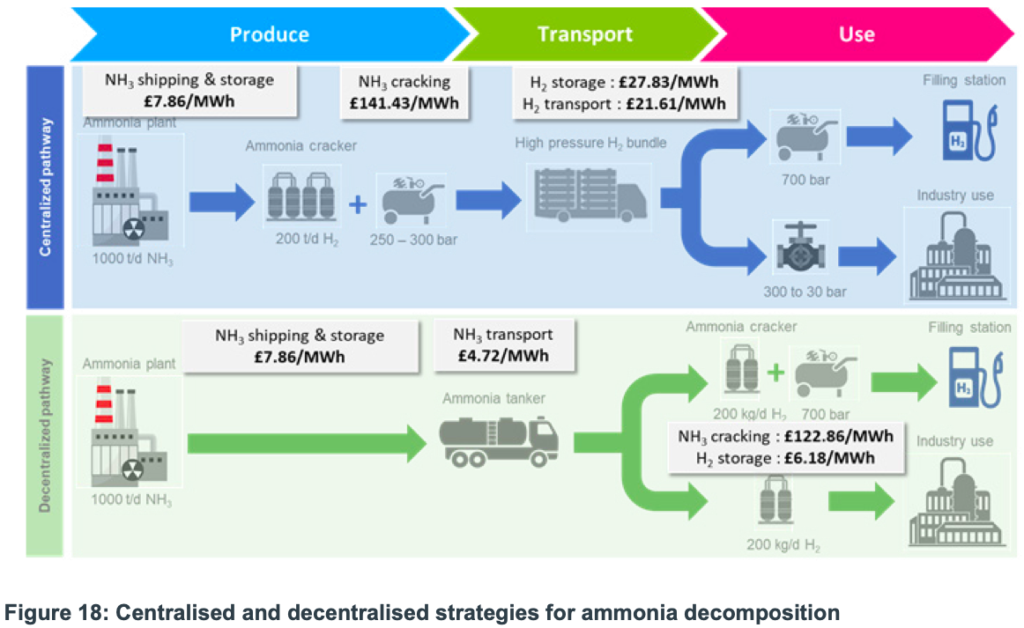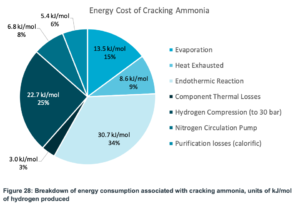Engie, Siemens, Ecuity, and STFC publish Feasibility of Ammonia-to-Hydrogen
By Trevor Brown on June 18, 2020

The UK’s Department for Business, Energy and Industrial Strategy (BEIS) recently published the feasibility study for its Ammonia to Green Hydrogen Project.
This studies the techno-economic feasibility of importing green ammonia in order to supply large volumes of high-purity low-carbon hydrogen in the UK. The project has been designed and delivered by a heavyweight consortium of ENGIE, Siemens, Ecuity Consulting, and the UK’s Science & Technology Facilities Council (STFC).
The feasibility study, which is publicly available, represents the conclusion of Phase One of this project. Phase Two is demonstration: “to raise the TRL [technology readiness level] of a lithium imide based ammonia cracker from 4 to 6/7,” meaning that the technology is ready for deployment.
We wrote about this project in September 2019, when it was awarded a £249,000 grant by BEIS through its £33 million Low Carbon Hydrogen Supply competition, which aims “to accelerate the development of low carbon bulk hydrogen supply.”
Ammonia as a hydrogen carrier
This project will demonstrate a new ammonia cracking technology with improved compactness, flexibility, efficiency, scalability and effectiveness in producing pure hydrogen compared to state of the art technologies. This will be achieved on a greater scale than has been achieved anywhere globally and will demonstrate how ammonia can act as profitable hydrogen carrier by enabling:
1). The storage of large amounts of energy generated by renewable sources at times when supply exceeds demand.
2). The transportation of hydrogen in the form of ammonia from distant generating sites to end users. This will enable cost effective distribution of renewable energy nationwide from very large-scale production units linked directly to large scale generation (e.g. offshore wind).
3). The cost effective importation of renewable energy from regions of the world where renewable electricity generation is very low cost. This will open up international trade in renewable energy and provide the UK with previously inaccessible options for decarbonisation.
UK Government, BEIS Low Carbon Hydrogen Supply Competition documents, Phase 1 report – Ecuity: Ammonia to green hydrogen project, April 2020
The feasibility study focuses on two main areas: cracker technology development, and energy system modeling.
The lithium imide catalyst that this project champions “shows great potential to improve the economics of ammonia decomposition with lower costs and higher performance than the current state of the art catalysts.”
The feasibility study connects the two areas of study: how much techno-economic improvement can be delivered using this new cracking technology; and whether this ammonia-to-hydrogen energy system should be centralized or decentralized.

New ammonia cracker catalyst

The project provides great detail on the operating parameters of the lithium imide system, “a new catalyst technology that could significantly improve the efficiency and economics of cracking ammonia.”
It also provides detailed analysis of the “the design of a 5kg/day cracker to test the performance of the catalyst in a demonstration pilot.”
The next stage of development of the cracker is to raise the TRL of a lithium imide based ammonia cracker from 4 to 6/7 by demonstrating and validating the feasibility of the technology developed. This includes understanding how the whole system behaves, but also specifically determining the performance of the catalyst and separation technology, through testing …
Once the system has been successfully operating under ‘low risk’ conditions, and the operating procedures have been fine-tuned, additional tests will be undertaken to assess the performance envelope of the ammonia cracker. This will include:
1). Variable hydrogen production rates
UK Government, BEIS Low Carbon Hydrogen Supply Competition documents, Phase 1 report – Ecuity: Ammonia to green hydrogen project, April 2020
2). Analysing the effect of reduced catalyst temperature on hydrogen quality
3). Lifetime tests – running the system for extended periods
4). Membrane robustness – varying temperature and pressure
This work builds on many years of research on the lithium imide catalyst system, led by Professor Bill David at STFC and Oxford University. This work has been presented at various stages of development at the annual Ammonia Energy Conference, including the 2016 paper Cracking Ammonia.
Centralized v. Decentralized systems

The conclusion of the feasibility study is that a decentralized cracking system offers the greatest economic benefit. This is based on a 200kg/day cracker unit, under the assumption of a 100 km domestic distribution distance, following a 3,000 km bulk ammonia import.
Notably, this decentralized model is increasingly advantageous as the domestic distribution distance increases.
The application of this technology is in high-purity hydrogen delivery, for PEM fuel cells, for example. There are many other applications for ammonia as a direct fuel, in power generation or maritime fuel, for example, where the energy cost of cracking ammonia can be avoided.
The purity of the hydrogen obtained through the modelling has been verified through small scale experimental development.The experimental rig yielded an H2 purity of 99.9975% with NH3 being below the detection limit of the FTIR (0.3 ppm). This will be verfied in a full scale demonstration of the technology in a real world scenario.
UK Government, BEIS Low Carbon Hydrogen Supply Competition documents, Phase 1 report – Ecuity: Ammonia to green hydrogen project, April 2020
Outcomes and Next Steps
This report represents the conclusion of Phase 1 of this project: the feasibility study. Phase 2 is the technology demonstration.
The study reveals how a decentralised cracking model and the design of 200 tonnes/day hydrogen could cost-effectively meet the needs of the energy system through 1000 distributed 200kg/day scale crackers.
This design will enable the importation of hydrogen in the form of ammonia from regions where renewable electricity generation is very low cost, revealing international trade opportunities for decarbonisation that were previously inaccessible and consequently placing the UK at the forefront of an emerging market.
What next?
Ecuity Consulting announcement, The role of ammonia in enabling a hydrogen future, June 9, 2020
The report draws an end to the first phase of the project’s research into the feasibility of the technology. This technology now needs to be demonstrated in a real-world scenario and the team will be looking for opportunities to take this forward in the future.